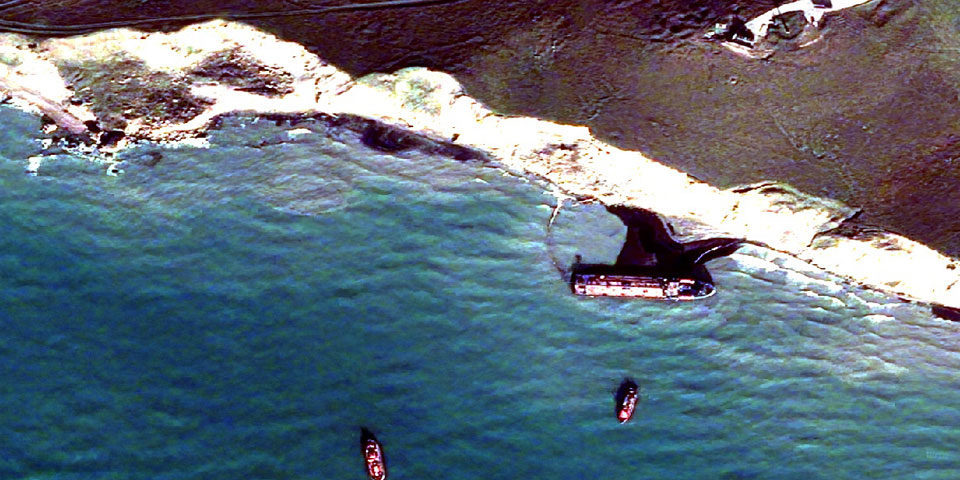The ongoing environmental impact of the Kerch Strait oil spill
Published: July 2025 · Categories: Publications, Ukraine

An accident involving two Russian oil tankers in the Kerch Strait in December 2024 spilled around 4,000 tonnes of heavy fuel oil. Notoriously persistent and difficult to clean up, the oil threatened ecosystems in the northern Black Sea. Six months on, Iryna Babanina examines how the situation continues to develop, how the war influenced the causes and outcome of the disaster and why past cases suggest that the ecological impacts may be substantial.
Overview of the Kerch Strait spill and response
On the 15th December 2024, the tankers Volgoneft-212 and Volgoneft-239, foundered in the Kerch Strait between Crimea and Russia. The ageing vessels were carrying around 4,000 tonnes of M-100 “mazut” heavy fuel oil. Both were obsolete: the Volgoneft-212 marked its 55th anniversary that day, whereas the Volgoneft-239 had been in operation for 52 years. Moreover, both were originally designed for inland navigation and, while they had been refurbished for near-shore maritime operations, were unsuitable for conditions with a wave height exceeding two metres. The weather conditions on 14-15th December had been intermittently stormy, with wind gusts up to 60 km/h. Volgoneft-212 split into two pieces and sank around 8 km from the shore on the Ukrainian side of the Kerch Strait. Volgoneft-239 also split in two, the bow section sank while the stern section drifted before stranding near Cape Panagiya on the Russian side of the Strait.
It was reported that around 4,000 tonnes — just under 30,000 barrels — of mazut spilled into the sea. Some of this would have been released at the time of the initial accident while the fuel was being kept warm and was more mobile. By 18th December, the mazut had come ashore near the Russian city of Anapa: a continuous slick around 1.5 km long could be seen on satellite imagery of the city’s central beach. Mazut later affected sites along the Crimean coast, spreading to Sevastopol in early January, and later affecting Yevpatoriya. On the 3rd February, the mazut reached Odesa’s coast.
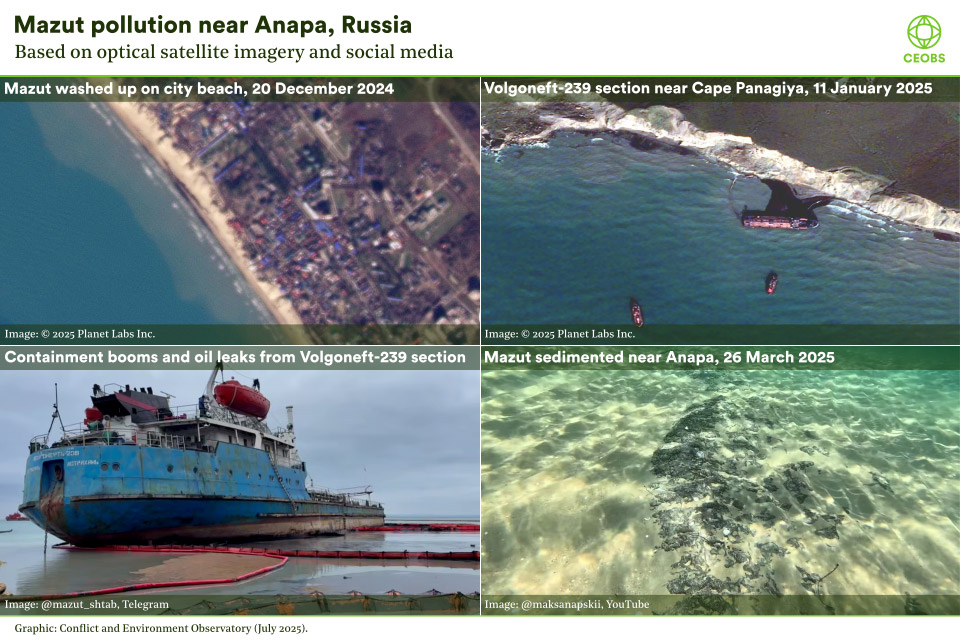
Russia was slow to respond to the spill, only introducing a federal emergency regime nine days later. The stranded section of Volgoneft-239 was encircled with floating booms, and a trench was later constructed around it to facilitate its dismantling, which took around three months to complete. It appears that no work was undertaken to immobilise the sunken ship sections after the disaster, nor to install any protective structures, except for warning buoys. Russian media reports suggest that divers examined the sunken parts in January, later sealing vents and damaged pipelines. Removal of the ship sections is planned for 2026.
The Russian Ministry of Emergencies (EMERCOM) requested activation of the International Charter: Space and Major Disasters, and with it assistance in remotely monitoring the spill. The Charter’s scope does not cover incidents of direct wartime damage but could be used for this indirect consequence of the war. Analysis identified extensive pollution from denser discharges from the wreck sites, and large slicks of lighter material on both sides of the Kerch Strait, and along the Kerch Peninsula. However, the analysis was limited to eastern Crimea. It later became apparent that at least some of the mazut had become entrained in the Black Sea Main Current, spreading for hundreds of kilometres in the first three weeks after the disaster.1 There are grounds to believe that secondary pollution incidents will be ongoing this summer, from both continued discharge from wrecks and from the remobilisation of sunken oil.
Monitoring the consequences of the spill
We used OSINT and remote sensing to monitor the potential spread of pollution,2 identifying continued leaks from the tankers. On the 18th December, a slick around 9.5 km long could be seen spreading eastward. On the 19th, a slick of 6 km spread to the northeast, and on the 31st, a third source of pollution appeared, with an 8 km long trace moving north-northeast. The origins of these slicks were assumed to be the locations of both parts of Volgoneft-212, and the bow section of Volgoneft-239.3
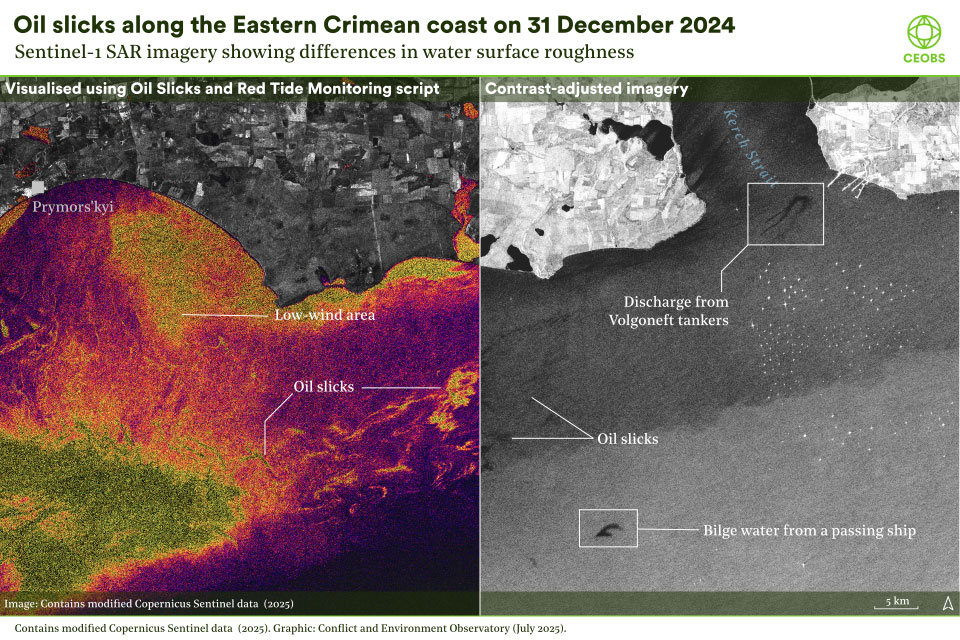
In early January, and after oil was detected near the shore between Sevastopol and Cape Aia, and in Sevastopol itself, a state of emergency was declared in Crimea. By the 11th January, a 30 km long slick was spreading from the Kerch Strait up to the Crimean town Feodosiya, pushed by north easterly winds. Sentinel-1 imagery from the following day reveals a 9 km slick moving south from the shipwreck zone, suggesting continued discharge or a series of discharges up to mid-January.
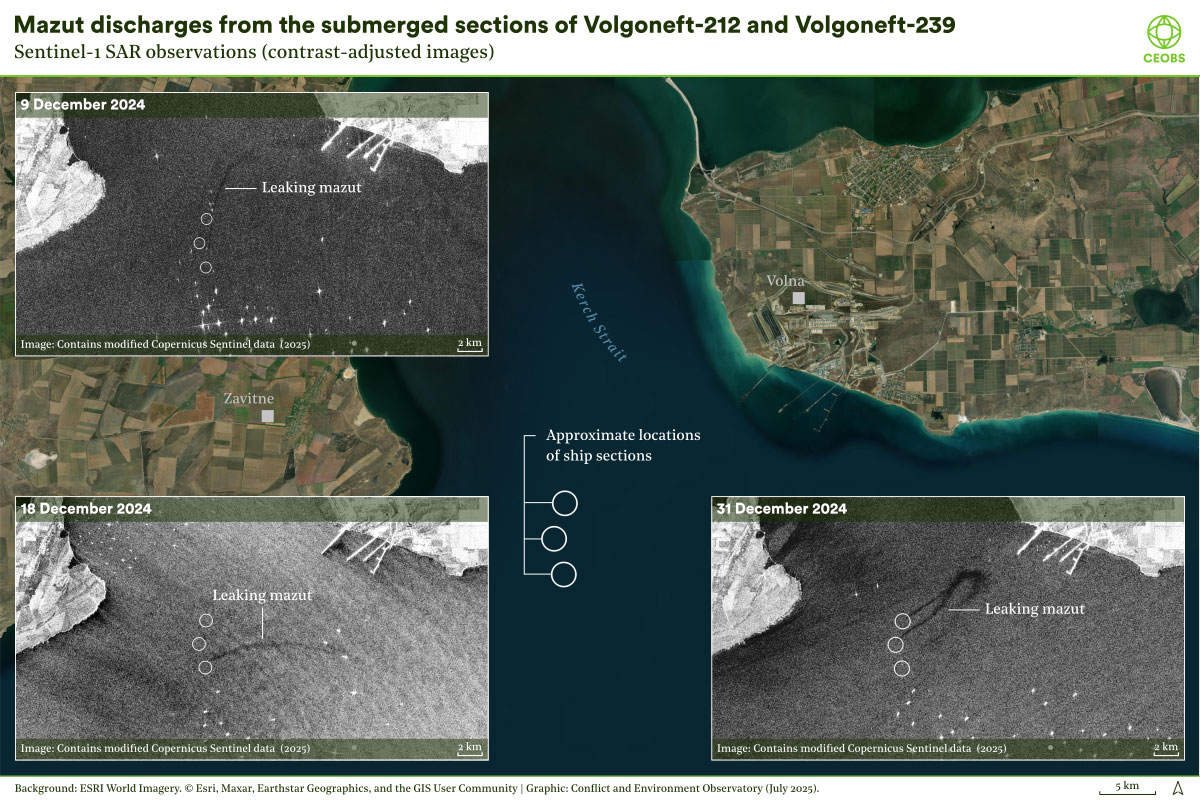
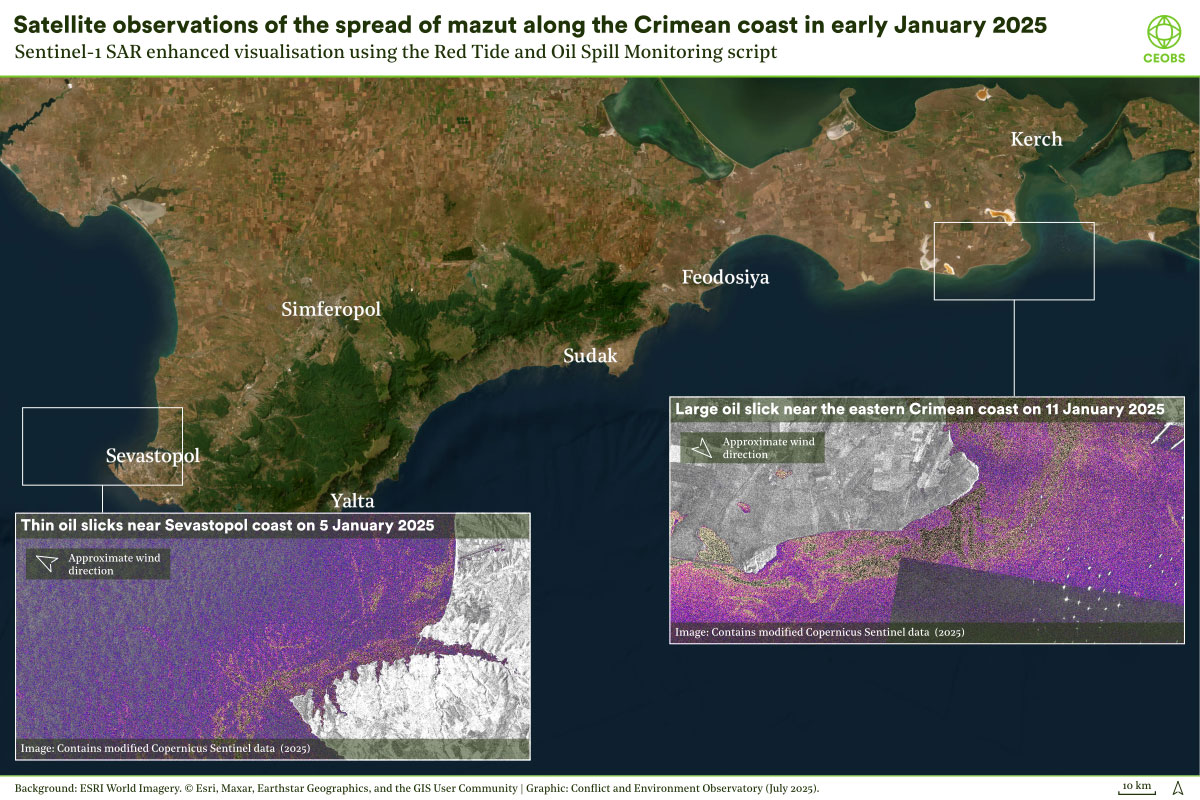
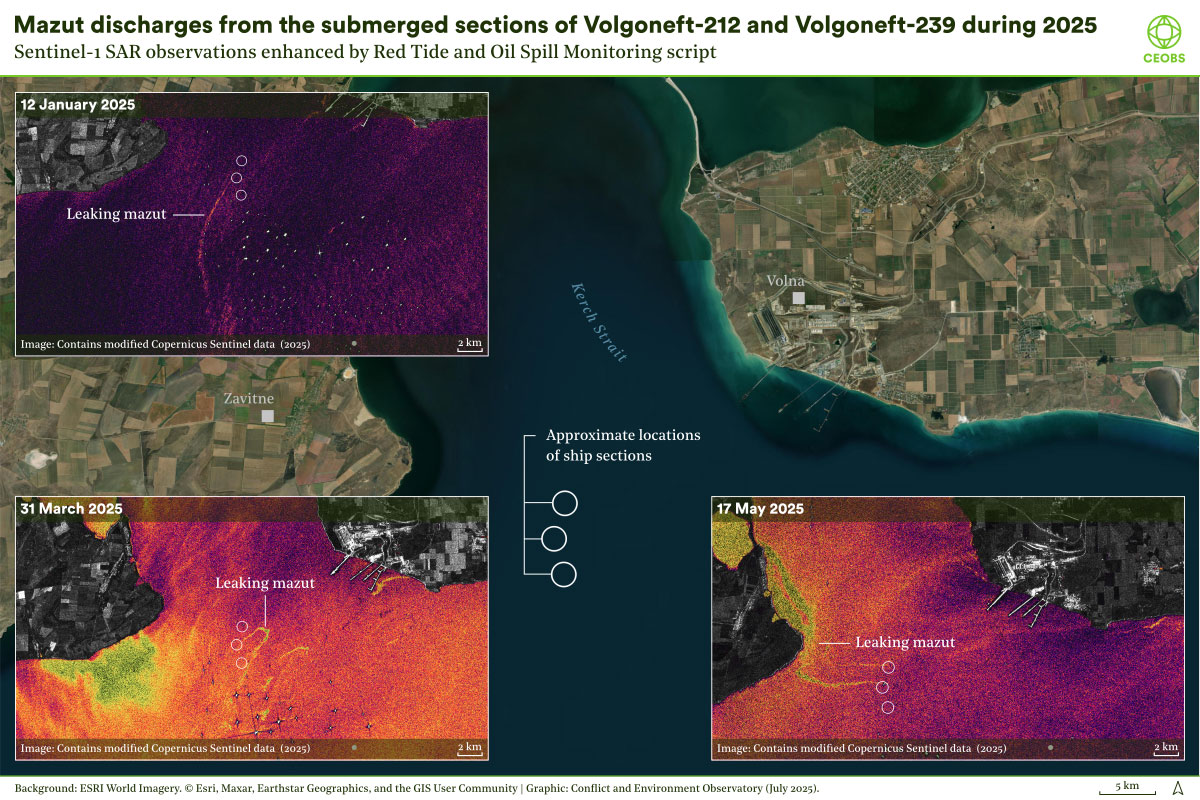
The discharges continued from March into May. Slicks were visible in the Kerch Strait on the 31st March, while one visible on the Russian side of the Strait appears consistent with media reports of mazut washed up on Anapa beaches after an early April storm. Anapa’s coast was also exposed to a 22 km long slick that can be seen drifting towards it on the 24th April. On the 17th May, a new discharge from the wreck area was seen feeding into a large slick near the Kerch coast, reinforcing fears that warmer summer waters may aid mazut remobilisation. Moreover, oil traces of various sizes were recorded by Sentinel-1 SAR images on the 18th, 22nd and 28th May, and the 10th, 17th, 21st, 22nd, 23rd, 27th, 28th and 29th June; a near daily pattern of discharges in late June. With no plans to remove the ships before 2026, the leaks can be expected to continue for a year.
Analysis of social media to the end of April suggests that tar balls and mazut slicks washed up repeatedly along the entire coast of southern Crimea. Many hotspots around the Kerch Peninsula, Sevastopol and Feodosiya areas are also areas of considerable ecological and recreational value. In late March, Ukraine’s State Environmental Inspectorate confirmed mazut pollution near Odesa’s coast, more than 600 km from the wreck site.
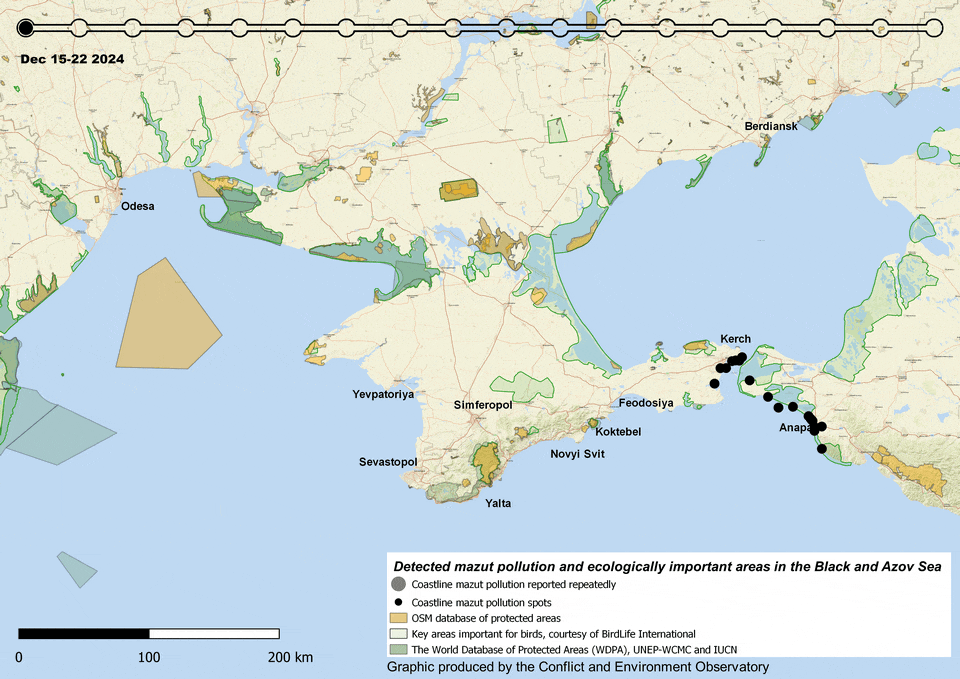
While we didn’t undertake our own modelling, our satellite and OSINT observations suggest that at least some of the pollution was picked up by the Black Sea’s Rim Current.4 This view is supported by Ukrainian researchers such as Pavlo Goldin. Similarly, researchers from the Ukrainian Scientific Centre of Ecology of the Sea sought to model the dispersion of the oil around the Black Sea using the OpenDrift model, which indicated that it would have reached Turkey, Bulgaria and Georgia. It is unclear if coastal eddies can play a role in remobilising sunken mazut, although its repeated appearance in the same areas suggests such a possibility. There have also been occasional reports of mazut in the Azov Sea, and further monitoring is advised during the summer months.
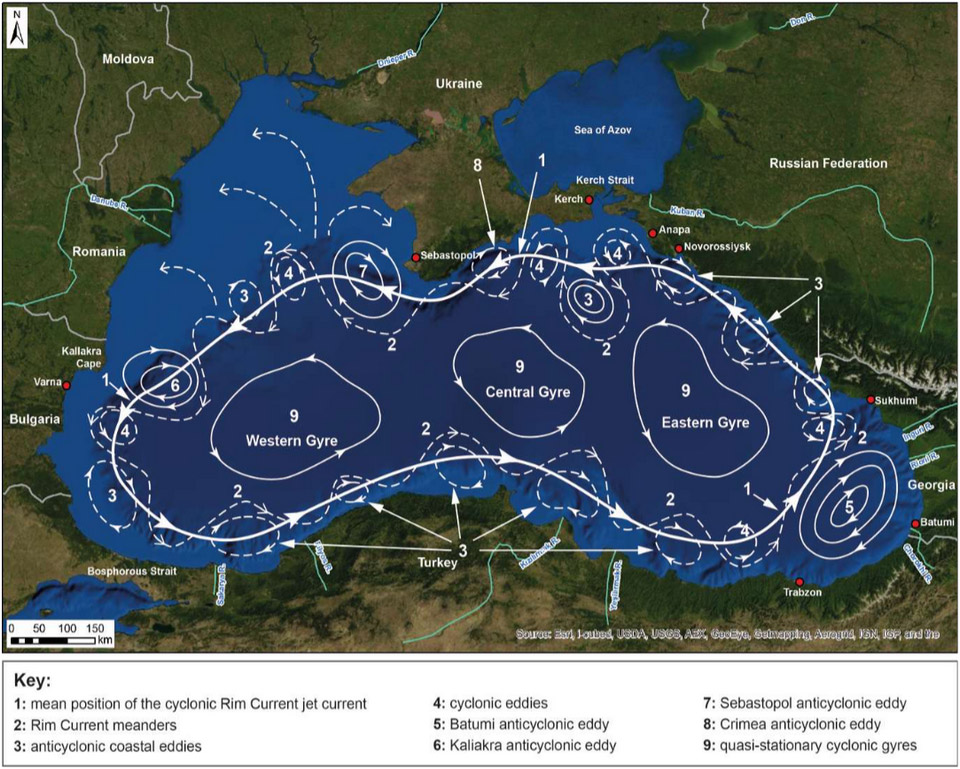
Source: Report “Providing data for water currents and connected with them waste streams in the Black Sea”; RedMarLitter was a strategic project co-funded by the EU under ENI CBC Black Sea Basin Programme 2014-2020.
Mazut: properties and environmental impact
M-100 mazut combines several heavy hydrocarbon fractions, and contains up to 3% sulphur and residual heavy metals, most often vanadium, iron and nickel, as well as organic contaminants such as polyaromatic-hydrocarbons (PAHs) and resins. Some of its properties are regulated by a Russian production standard and it is highly viscous below 25℃. Its density is usually higher than petrol and diesel fuel and is comparable with that of water. During transportation, it is kept at 45℃ to facilitate unloading.
In the marine environment mazut is influenced by processes such as evaporation, flocculation, emulsification, oxidation, sedimentation and biodegradation. Its behaviour is quite different to the surface slicks associated with lighter hydrocarbon fractions, and heavy fuel oils like mazut are more environmentally persistent. Forming lumps, its outer layers oxidise to a dense tar, preventing them from dispersing. Oil droplets or tar balls can float in the water column and be carried over long distances. Mazut has near-neutral buoyancy in low-salinity and brackish water at moderate temperatures, often floating in the water column or rolling over bottom sediments if mixed with sand and seaweed. Heavy oil in the seabed lasts much longer than surface oil and continues to contaminate the environment through secondary discharge and sediment motion. While heavy fuel oils can be recovered with skimmers and vacuum pumps early after a spill, stormy weather and an inadequate response meant that this was not attempted.
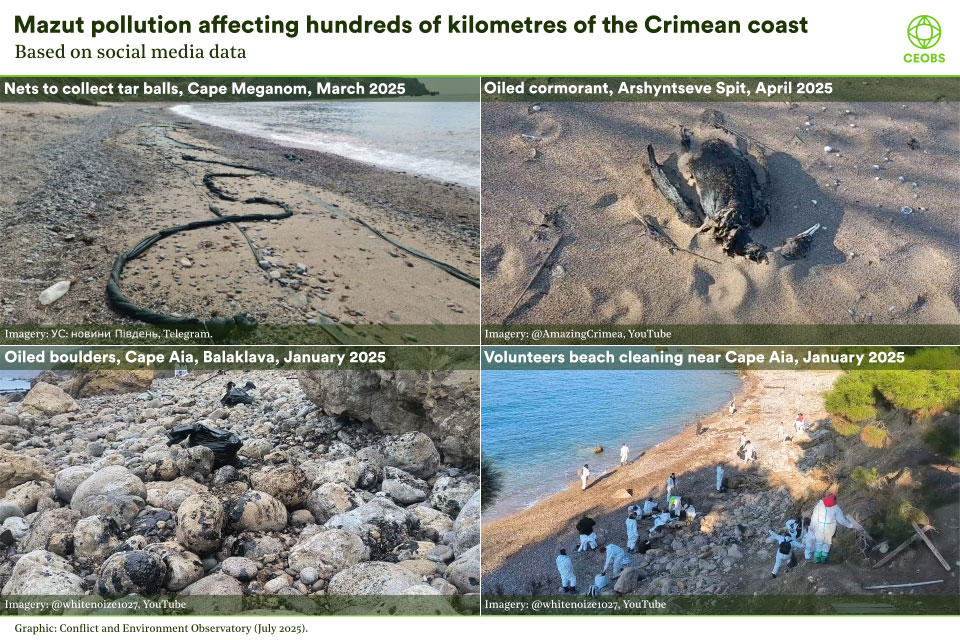
Nevertheless, Russian sources suggest that up to 475 km of shoreline was cleaned, and 158,000 tonnes of polluted sand was collected, with sea bottom clean-up continuing near Anapa into mid-June. In Crimea, around 500 km of shoreline was examined and 250 km cleaned, 884 tonnes of contaminated sand and gravel were collected, 842 tonnes of which came from Sevastopol. Media reports suggest that some of the oil collected in Crimea was incinerated; in Russia some was disposed of in landfills, triggering objections from some local communities. However, it is difficult to track the fate of the waste and large volumes of contaminated sand still await disposal.
Thousands of volunteers reportedly engaged in clean-up efforts in Anapa and around Crimea but this work is not without risks. In January it was reported that 146 people had sought medical attention after helping to clear oil, while a 17-year old college student with asthma fell ill and died before ambulances could reach him. The labour-intensive work has to be repeated as more mazut washes up after being mobilised by warmer waters, however it is unclear if the Russian authorities have the capacity or inclination to implement this.
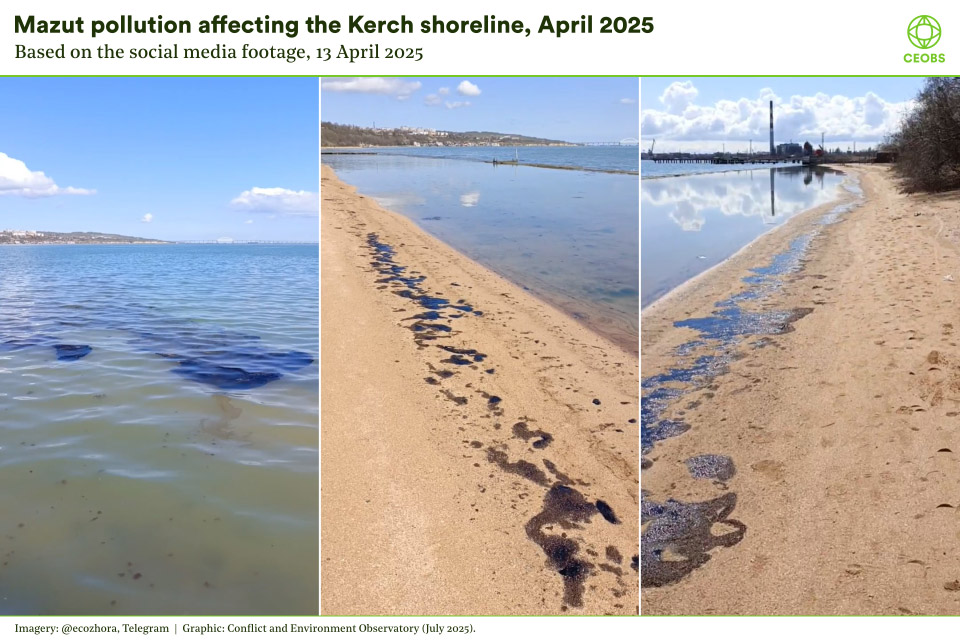
Impact on protected areas and bird migration sites
Crimea’s southern coast is an area of considerable ecological, recreational and aesthetic value, although one already affected by the war. Local environmental groups have reported that the incident has affected many ecologically important areas with unique biota, as well as numerous important areas for birds; this includes the Opuk reserve and Meganom Peninsula. The Azov and Black Sea coasts are important stopovers in the Black Sea-Mediterranean Flyway, and home to a number of rare and visiting species. Some monitoring of the impact on bird populations is believed to have been undertaken by Russian academic institutes. There are no precise figures on the numbers of seabirds and marine mammals affected. The Russian Delfa Center tracked cetacean deaths in the immediate aftermath, whereas Ukraine’s environment ministry suggested that 700 birds and 60 dolphins had died by mid-April. As might be expected, there has been no coordinated effort to monitor the impact on marine life, and with calculating deaths at sea difficult these figures are likely to be a substantial underestimate.
Washed-up mazut persists on shorelines because of its high viscosity, it’s especially dangerous for waterfowl and seabirds, which can get smothered and swallow the oil while preening. Oiled birds typically require degreasing, sorbent treatment and rehabilitation for 4-6 weeks until their feathers recover. Such care is extremely resource and labour intensive, with a survival rate below 10% because of delayed poisoning effects. The timing of the recurring incidents has coincided with the spring migration, which takes place between late February and April.
The Kerch Strait has already been under increased environmental pressure marine traffic. At least four oil terminals — Port Kavkaz, Taman, Taganrog and Novorossiysk — provide large-scale oil trans-shipment, and Volgoneft ships were often used to carry oil from refineries in the Volga region to these terminals. Spills from offshore ship-to-ship transfers, bilge water and illegal waste dumping all contribute to pollution in the area.
Volgoneft tankers: technical problems, “Shadow Fleet” involvement and past incidents
Volgoneft series tankers were built between 1963-80 and were a popular design for river and nearshore marine tankers transporting light and heavy oil products.5 They were one of the first to use a double hull and bottom, but no longer meet MARPOL maritime safety requirements and were expected to be decommissioned from 1 January 2015; the Russian Ministry of Transportation extended their service life. They have a number of other safety issues, such as susceptibility to deformations of the hull. The middle sections of the Volgoneft-212 and Volgoneft-239 had been cut and re-welded during refurbishments, weakening them further.
The incident shed light on the so-called “Shadow Fleet”: around 435 tankers with disguised or diluted ownership information that are employed to transport Russian crude oil and petroleum products to circumvent the price caps introduced in 2022. AIS spoofing and ship-to-ship transfers are common practices, although concealing ownership is a subtler approach. Russian tankers were transferred to new management companies by purchasing vessels older than 15 years, which still carry valid insurance, and by acquiring vessels older than 20 years that would otherwise have been decommissioned. Shadow Fleet vessels are not regularly inspected and are in poor condition, increasing the risks they pose to the environment. Volgoneft-212 and Volgoneft-239 were Russian flagged so not part of the fleet per se but it is suspected that they were shuttling oil to Shadow Fleet vessels.
After the disaster, Russian officials at first said that there was no practice in tackling mazut spills, which is untrue. The wreck of the Erika in 1999 in French waters involved 30,000 tonnes of heavy fuel oil. Spain’s 2002 Prestige disaster was probably the largest accident of the type, spilling more than 70,000 tonnes of mazut and contaminating about 3,000 km of coastline. Both saw a substantial response involving manual labour in place of the sorbents and dispersants used for lighter oils. Moreover, two major incidents involving Volgoneft tankers carrying mazut have been well-documented.6
Following a similar incident in 2007, which involved less than half of the volume of mazut spilled in 2024, oil continued to be washed up for several months. Around 2,500 people and 300 vehicles were engaged in the shore clean-up, about 40,000 tonnes of sand were collected on the Russian side and more than 7,000 on the Ukrainian side of the Strait. Some of the oil migrated into the Azov Sea, and may have been carried back into the Kerch Strait during the summer and autumn. The incident was deemed severe enough to trigger a UNEP post-disaster needs assessment and the following years saw repeated water and sediment sampling campaigns by Russian and Ukrainian institutions. These found hydrocarbon and PAH levels exceeding permissible levels by 1.5-7 times. While concentrations decreased over time, intermittent peaks potentially indicated the mobilisation of pollutants from bottom sediments during warmer months. The incident is thought to have killed 30,000 birds.
Legal protection of the Black Sea environment
Three primary legal instruments are relevant to this case. The 1992 Convention on the Protection of the Black Sea against Pollution (Bucharest Convention) addresses regional cooperation against pollution from land-based and marine sources, incorporating an additional protocol on cooperation in combating pollution by oil. It envisages technical cooperation between affected parties and requires the responsible party to share data with other affected countries.
More generally, the UN Convention on the Law of the Sea (UNCLOS) and International Convention or the Prevention of Pollution from Ships (MARPOL) both contain rules relevant to oil spills.7 However, the lack of tangible liability mechanisms — and the challenge of their application during conflicts — makes these conventions mostly declarative in this context.
The war clearly contributed to the disaster and has compounded its impacts. The obsolete Volgoneft tankers were operating in a “grey zone” with minimal safety inspections. Data exchange and cooperation between Russia and Ukraine has been stopped, and the scope for foreign assistance was also limited. Meanwhile the Black Sea remains a battlefield and the wrecks and their slowly discharging contents a lower priority as a result.
Conclusion
This latest incident involving Volgoneft tankers is one of the worst oil spill disasters to have affected the Black Sea. Moreover, it has affected a sea that has already been severely impacted by war since 2022, whether through naval operations and coastal warfare, shady wartime shipping, or the massive influx of polluted and nutrient-rich waters following the destruction of the Kakhovka Dam.
The incident shows how the ongoing conflict is preventing effective response and cooperation between the countries that share the Black Sea basin, and is making independent multilateral environmental monitoring impossible. Data from remote assessment and the analysis of past incidents suggests that the ecological consequences of the incident are severe and will have lasting effects on the marine environment, effects that the politicised context in which the incident occurred will have exacerbated. With the war ongoing, many of the factors that contributed to this spill are still in place, increasing the likelihood that we will see further incidents in future.
Iryna Babanina is a Researcher with CEOBS based in Kyiv.
- The Ukrainian Scientific Centre for the Ecology of the Sea used the NOAA GNOME model to predict the spread of pollution in the early stages of the incident. While the GNOME (General NOAA Operational Modeling Environment) suite does contain some data for a “Generic heavy fuel oil”, such as density and viscosity at various temperatures, it cannot specifically model M-100 mazut.
- Sentinel-2 optical data enhanced with the OSI (Oil Spill Index) custom script can be used to detect oil slicks. However, slicks are not always distinctive and need to be differentiated from phytoplankton and sediments. The complex bathymetric profile and circulation patterns of the Kerch Strait also make visual identification difficult. Moreover, the high viscosity of mazut in cold water means that most of it may move in the water column in the form of chunks, droplets or tar balls rather dense surface slicks. Synthetic Aperture Radar (SAR) is effective for oil spill identification. This is based on the ability of oil slicks to flatten the water surface, smoothing waves and changing the reflection of radar signals. We used a combination of Sentinel-1 SAR observations, a Water Surface Roughness Visualization Script, and a custom Oil Slicks and Red Tide Monitoring Script. Meteoblue.com data was used to determine wind directions.
- 1) 45.0833, 36.5359; 2) 45.0698, 36.5301; 3) 45.0615, 36,5478.
- The Black Sea’s circulation is defined by a complex set of meteorological, hydrological and depth profile factors. The sea has an average salinity of 17-18‰ and a closed circulation pattern. The Black Sea Main Current, or Rim Current, is a consistent cyclonic boundary current that generally coincides with the outlines of the continental slope. There are two main cyclonic currents called the Eastern Gyre and the Western Gyre, related to the shape of the coastline dividing the sea into two basins. The circulation includes smaller quasi-permanent anticyclonic gyres south of the Crimean peninsula (the Sevastopol eddy), and in the southeast (the Batumi eddy), as well as a number of smaller cyclonic and anticyclonic vortexes (Shapiro, 2009). The Rim Current is assumed to intensify in winter and spring, suggesting faster pollutant movement. Most of the time freshened waters from the Azov Sea, which are influenced by the inflow of the rivers Don and Kuban, and which have a salinity of 12-13‰, are driven by north-easterly winds through the shallow and narrow Kerch Strait into the Black Sea; however, more saline and dense water inflows into the Azov Sea during low-wind periods (Zavialov et al., 2020).
- The Russian Ship Register lists 209 ships of this type: 65 are disposed of; 66 are docked; a few work as pumping or storage stations, or are awaiting refurbishment or disposal; 73 are operating or leased, and two were lost in this disaster.
- During a storm in 1999, a Volgoneft-248 tanker carrying 4,365 tonnes of heavy oil broke in two near the Istanbul shore in the Sea of Marmara, spilling 1,279 tonnes of heavy fuel oil from two damaged tanks. The stern section with two tanks was driven ashore, while the bow section with four full tanks (2,073 tonnes) sank in shallow water and leaked oil slowly but continuously until divers plugged tank vents and damaged pipelines; it may leaked until the following summer (Otay and Yenigun, 2001). In November 2007, an unusually strong storm hit the Kerch Strait. In total, 13 ships were impacted, Volgoneft-123 suffered damage, while Volgoneft-139 split in two, spilling about 1,300-1,800 tonnes of mazut, its bow sank near the main navigation channel of the Kerch Strait and the stern was cast ashore. This incident is one of the most well-researched and documented Black Sea oil spill disasters and can provide useful insights into how the current situation may develop (Korshenko et al. 2011).
- Art. 196 of the 1982 United Nations Convention on the Law of the Sea declares that states shall ‘take all measures necessary to prevent, reduce and maintain under control the pollution of the marine environment by the use of technology under their jurisdiction or control…’ The International Convention or the Prevention of Pollution from Ships 1973, supplemented by the 1978 Protocol, contains rules for the prevention of pollution of the sea by oil and harmful substances, as well as pollution caused by the ship operation.

